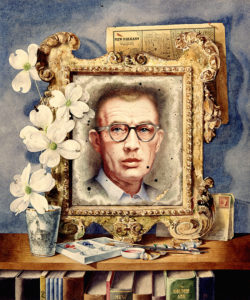Boyd Cruise
Alvyk Boyd Cruise was a multitalented artist and historian in New Orleans during the mid-twentieth century.

Courtesy of The Historic New Orleans Collection
Boyd Cruise Self-Portrait. Cruise, Boyd (Artist)
Alvyk Boyd Cruise combined his artistic talents with a love of history to produce an endearing portfolio of paintings that romanticized southern Louisiana’s built environment—particularly the French Quarter and plantations along River Road. The level of detail in the works of this artist and historian, from building signs and period dress to architectural elements, faithfully reflect the reality of everyday life in Louisiana. Many of his works were commissioned by the Depression-era federal Historic American Buildings Survey (HABS) project to document Louisiana’s architectural heritage. Cruise was also the first director of The Historic New Orleans Collection, a renowned private archive of art and historic documents, located in the French Quarter.
Early Life and Education
Born in Cains, Mississippi, on October 20, 1909, Cruise was the son of Ethel Flowers and William Dallas Cruise. Shortly after Boyd’s birth, the family moved to Crowley, Louisiana, where Cruise attended grammar school. In 1918 the family moved to Lake Charles, where Cruise completed his high school education. By his junior year of high school, he knew he wanted to be an artist and began designing and painting stage sets for the Lake Charles Little Theater under the direction of Rosa Hart. With Hart’s encouragement, Cruise applied for a scholarship to the New Orleans School of Art, which was run by the Arts and Crafts Club of New Orleans.
After starting his studies in New Orleans in the fall of 1928, Cruise won the Blanche S. Benjamin Prize and a scholarship to the Pennsylvania Academy of the Fine Arts in 1931. During his four years in Pennsylvania, he earned several awards, including the Cresson Traveling Scholarship Award, which twice allowed him to travel to Europe. Much of his art education was completed as a direct result of these scholarships and other prizes.
A Developing Art Career
After his return to New Orleans, Cruise began working with architect Richard Koch on the HABS project. A Works Progress Administration (WPA) initiative designed to document the best examples of American architecture, the survey included elevations, floor plans, and photographs. Koch hired Cruise to paint watercolors that would complement photographs taken by him and Samuel Wilson Jr. Cruise painted hundreds of watercolors of Louisiana buildings, particularly the abundance of antebellum architecture.
Koch also introduced Cruise to the plan books and watercolor drawings housed in the Notarial Archives, which allowed Cruise to include the original facades of buildings that had been either altered or destroyed. Critics applauded Cruise’s use of color and architectural detail, which presented a realistic view of New Orleans and Louisiana. This work incited a lifelong passion in Cruise to preserve French Quarter buildings and promote Louisiana history. He concentrated on endangered buildings so that future generations would be able to look at his paintings in the event the actual buildings were lost.
Known for his trompe l’oeil (“deceive the eye”) style, Cruise also produced still lifes, floral paintings, portraits, pen and ink drawings, and a few pieces of pottery. His floral and botanical arrangements especially drew positive reviews, which often compared his paintings to fresh flowers laid on the canvas. Cruise taught at the Arts and Crafts Club, Newcomb College, and the John McCrady Art School. He presented his work in exhibitions, including several solo and out of state shows. Fine arts and manuscripts dealer Albert Lieutaud became Cruise’s manager and arranged to have Cruise represented by the Kennedy Galleries in New York City. When World War II halted the HABS project, Cruise joined the camouflage division of the navy, producing dioramas for war bond drives.
From Artist to Historian
When Cruise began an architectural painting, he spent hours doing meticulous research into the building and its place in the city. His work conveyed such fullness and richness of detail that observers were transported into the scenes, almost as if they were the people painted within them. This talent to depict life in early New Orleans led Koch to introduce Cruise to General L. Kemper and Leila Williams. Cruise became the cataloger and curator of their art collection, which later became the foundation for The Historic New Orleans Collection. One of the duties General Williams assigned to Cruise was to complete an index of the Louisiana Historical Quarterly. He not only compiled the index of the thirty-three volumes but also illustrated and published it in 1956.
Cruise’s final painting, completed in 1962, depicted the Beauregard–Keyes House for friend and author Francis Parkinson Keyes. During this same period, Cruise served as executive director of the Vieux Carré Survey, a project that traced the provenance of the buildings in the French Quarter. Completed in 1966, the survey documented the properties of more than one hundred blocks in New Orleans’s oldest neighborhood and included maps, photographs, chains of title, and newspaper clippings. To this day, the Vieux Carré Survey, archived at The Historic New Orleans Collection, remains one of the most requested resources for those researching New Orleans history.
When the Williamses established The Historic New Orleans Collection in 1966, Cruise became its first director. He opened and administered the research library, planned the Collection’s first exhibits, and organized the Collection’s Royal Street complex into a cohesive whole. Cruise held the position of director until 1974, when he retired to concentrate on his research and writing; he retained the title of director emeritus. Using research he had gathered for more than thirty years, Cruise began work on a comprehensive book on New Orleans artists, and The Historic New Orleans Collection published the volume—Encyclopaedia of New Orleans Artists, 1718–1918—in 1987. By this time, Cruise’s health was failing, and he died on December 4, 1988 at the age of seventy-nine.
